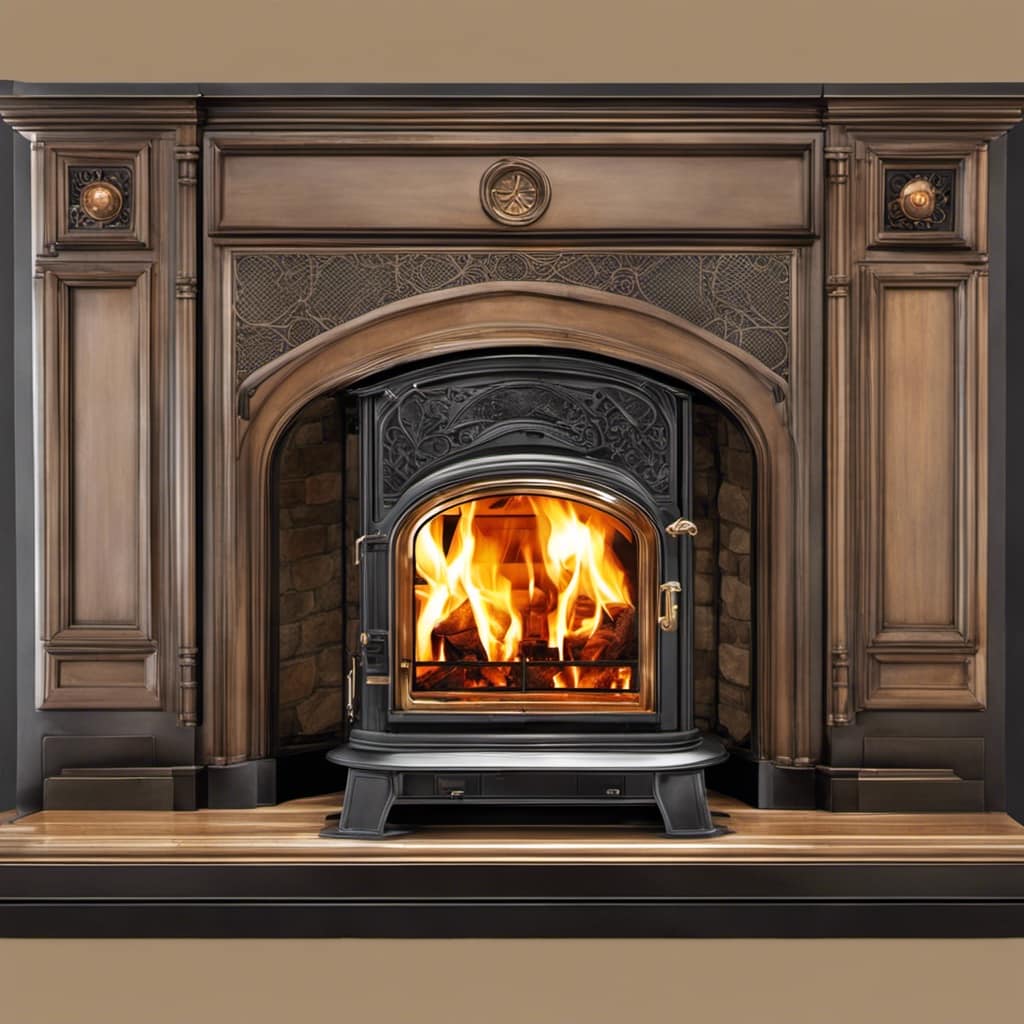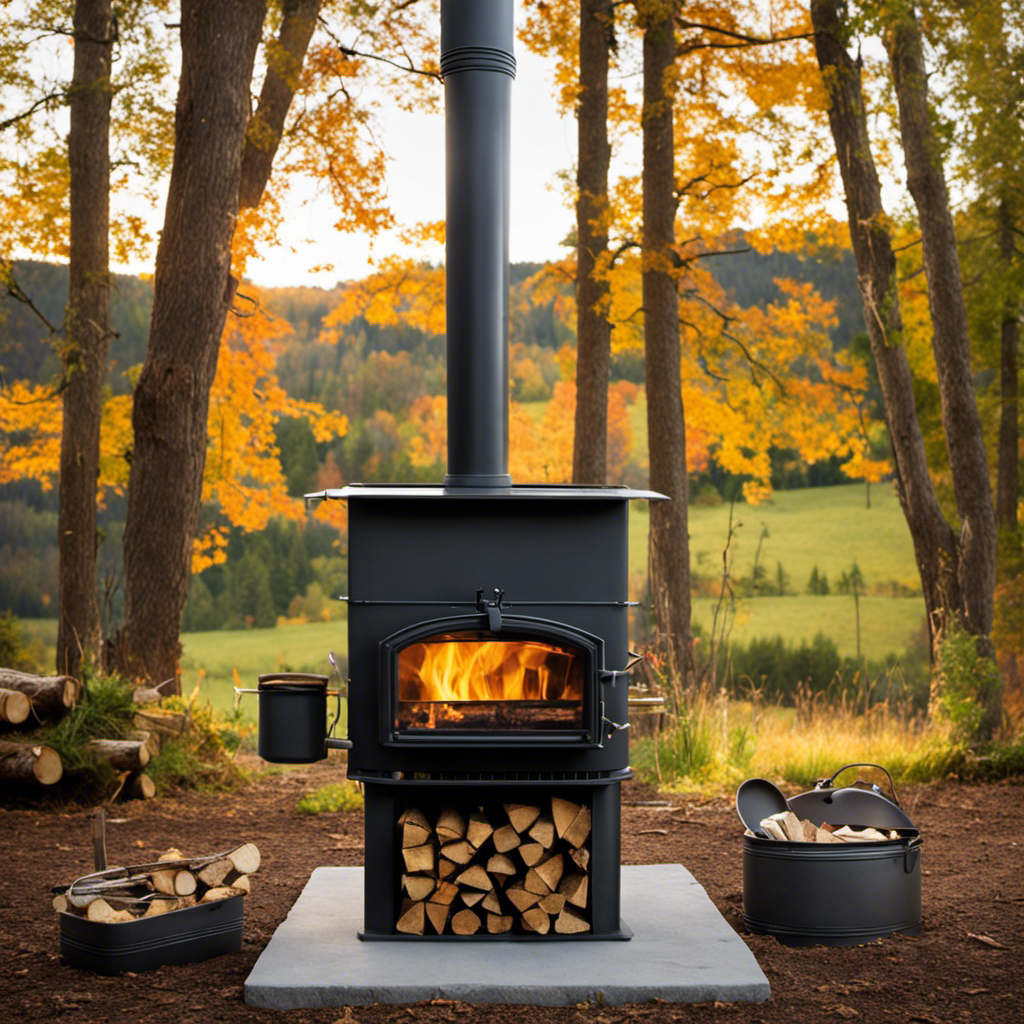Have you ever questioned the role of a wood stove damper? Allow me to explain it to you.
The damper plays a crucial role in controlling the airflow, which directly impacts the combustion process. By regulating the oxygen intake, the damper allows you to control the burn rate and maximize the heat output.
In this article, we will explore the various functions and benefits of the damper on a wood stove. So, let’s dive in and uncover the secrets behind this essential component.
Key Takeaways
- The damper on a wood stove serves multiple functions, including controlling airflow, regulating the burn rate, maximizing heat output, and preventing smoke buildup.
- It enhances the energy efficiency of the wood stove by allowing for precise control over airflow and temperature, reducing smoke and preventing backdraft, and ensuring optimal performance.
- The damper promotes fuel efficiency by controlling air intake, helps retain heat by preventing excessive heat loss, and reduces the risk of harmful emissions.
- It also regulates the intensity of the fire, temperature inside the wood stove, and allows for a comfortable and efficient heating experience while preventing smoke backdraft and improving indoor air quality.
How the Damper Controls Airflow
The damper controls the airflow in my wood stove, allowing me to adjust the temperature. Maintaining the damper is crucial for the efficiency and longevity of the stove. It’s important to regularly clean and inspect the damper to ensure it’s functioning properly. A clogged or malfunctioning damper can hinder the stove’s performance and even pose a safety risk.

There are different types of dampers, such as a manual damper or a bypass damper. A manual damper is typically located on the flue pipe or chimney and can be adjusted by hand. This allows for precise control over the airflow and temperature. On the other hand, a bypass damper is located on the stove itself and redirects the airflow to bypass the firebox. This type of damper is particularly effective in reducing smoke and preventing backdraft.
The Impact of the Damper on Combustion
Using the damper correctly and efficiently can significantly enhance the combustion process in my wood stove. The damper plays a crucial role in regulating the airflow and controlling the intensity of the fire. Here is how it impacts energy efficiency and prevents smoke buildup:
-
Fuel efficiency: By adjusting the damper, I can control the amount of air entering the stove. This allows for optimal oxygen levels, promoting a more efficient burn and reducing fuel consumption.
-
Heat retention: The damper helps maintain a steady temperature by preventing excessive heat loss through the chimney. This improves the stove’s energy efficiency and ensures that more heat is radiated into the room.

-
Smoke prevention: When the damper is properly adjusted, it creates a strong draft that pulls smoke and gases out of the stove and up the chimney. This prevents smoke buildup inside the stove and reduces the risk of harmful emissions.
By understanding the impact of the damper on energy efficiency and smoke prevention, I can optimize its usage to improve the performance of my wood stove.
Now, let’s explore how regulating oxygen intake with the damper further enhances the combustion process.
Regulating Oxygen Intake With the Damper
Since I can control the amount of oxygen entering the stove by adjusting the damper, I can regulate the intensity of the fire.

The damper plays a crucial role in regulating the temperature inside the wood stove. By opening the damper, more oxygen is allowed in, resulting in a hotter fire. Conversely, closing the damper restricts the oxygen flow, reducing the intensity of the fire and lowering the temperature.
This level of control is essential for maintaining a comfortable and efficient heating experience.
Additionally, the damper also serves another important purpose – preventing smoke backdraft. By adjusting the damper properly, I can ensure that the smoke is directed up and out of the chimney, rather than entering the room. This not only improves indoor air quality but also reduces the risk of carbon monoxide poisoning.
Controlling Burn Rate With the Damper
I can effectively control and adjust the burn rate of the fire in my wood stove by manipulating the damper with both precision and ease. The damper plays a crucial role in determining the amount of oxygen that reaches the fire, which directly affects the burn rate.

Here’s how the damper position impacts smoke emission and fuel consumption:
-
Damper closed: When the damper is fully closed, airflow is restricted, resulting in reduced oxygen supply. This leads to incomplete combustion, causing more smoke emission.
-
Damper partially open: With the damper partially open, there’s a balanced airflow, allowing for efficient combustion. This minimizes smoke emission while optimizing fuel consumption.
-
Damper fully open: Opening the damper completely allows for maximum oxygen intake, resulting in a hot, intense fire. This can lead to higher fuel consumption but also generates more heat output.

Maximizing Heat Output With the Damper
Although the damper can impact fuel consumption, understanding its position allows me to maximize heat output with precise control.
The damper on a wood stove plays a crucial role in improving energy efficiency and reducing smoke emissions. By adjusting the damper, I can regulate the amount of air entering the stove, thereby controlling the burn rate and heat production.
When the damper is fully open, more air is allowed in, resulting in a hotter and more intense fire. On the other hand, closing the damper restricts airflow, leading to a slower burn and reduced heat output.
Frequently Asked Questions
How Do I Clean and Maintain the Damper on a Wood Stove?
To clean and maintain the damper on a wood stove, start by making sure it’s cool. Remove any debris or creosote buildup using a wire brush or vacuum. Check for any common problems like rust or blockages and address them accordingly.

Can a Damper Be Installed on Any Type of Wood Stove?
Yes, a damper can be installed on any type of wood stove. The installation process involves attaching the damper to the stovepipe. The benefits of using a damper include improved heat control and increased fuel efficiency.
Are There Any Safety Precautions to Consider When Using a Damper on a Wood Stove?
When using a damper on a wood stove, it is important to follow safety precautions. Make sure the damper is properly adjusted to control airflow and prevent smoke from escaping into the room.
What Are Some Common Signs of a Malfunctioning Damper?
Common signs of a malfunctioning damper include difficulty in controlling the airflow, excessive smoke in the room, and decreased heating efficiency. It’s important to address these issues promptly to ensure the safe and efficient operation of the wood stove.
Is It Possible to Retrofit an Older Wood Stove With a Damper?
Yes, it’s possible to retrofit an older wood stove with a damper. Retrofitting offers several benefits, such as improved control over airflow and increased efficiency. A damper is effective in regulating heat output and reducing heat loss through the chimney.

Conclusion
In conclusion, the damper on a wood stove plays a crucial role in controlling airflow, combustion, and heat output.
It regulates oxygen intake, allowing for efficient and safe burning of wood.
By adjusting the damper, one can control the burn rate and maximize the stove’s heat output.
Its importance can’t be overstated; it’s the key to a well-functioning wood stove, ensuring warmth and comfort in any living space.

Growing up surrounded by the vast beauty of nature, Sierra was always drawn to the call of the wild. While others sought the comfort of the familiar, she ventured out, embracing the unpredictable and finding stories in the heartbeat of nature.
At the epicenter of every remarkable venture lies a dynamic team—a fusion of diverse talents, visions, and passions. The essence of Best Small Wood Stoves is crafted and refined by such a trio: Sierra, Logan, and Terra. Their collective expertise has transformed the platform into a leading authority on small wood stoves, radiating warmth and knowledge in equal measure.











